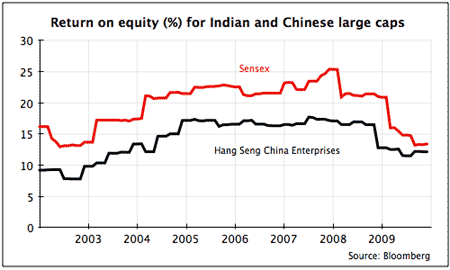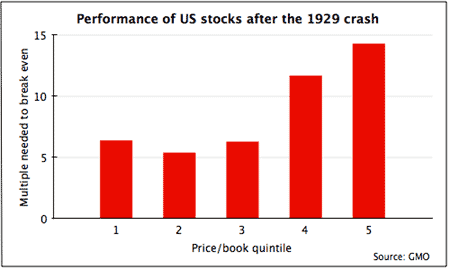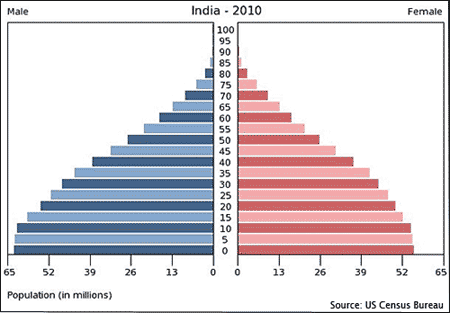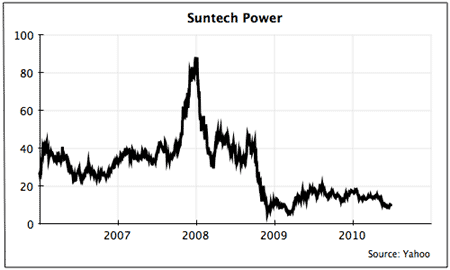Why India deserves to be more expensive than China
Investors have often complained that India is an expensive market, having long traded on higher valuations than its Asian peers. But there are some very good reasons why Indian companies are valued higher than those in China, for example. Cris Sholto Heaton explains why it's worth paying more.

"India is an expensive market." It's a common complaint among emerging-market investors. I've said it myself here.
India has long traded on higher valuations than its peers in Asia. Is there any justification for this? Are Indian stocks a better bet than Chinese ones over the long run?
It's hard to be sure. But I've looked into it, and I reckon there's one reason why investors might be happy to pay a higher price for India
MoneyWeek
Subscribe to MoneyWeek today and get your first six magazine issues absolutely FREE

Sign up to Money Morning
Don't miss the latest investment and personal finances news, market analysis, plus money-saving tips with our free twice-daily newsletter
Don't miss the latest investment and personal finances news, market analysis, plus money-saving tips with our free twice-daily newsletter
Sometimes quality is worth the cost
Some investors cite the high profitability of Indian firms as the main reason for high valuations. You can see this by comparing the return on equity in India with that in China. (For China, I'm using Hong Kong-listed Chinese stocks rather than the mainland market, because few foreigners are allowed to invest directly in Shanghai.)
Return on equity (ROE) is net income divided by net assets (net assets is also known as book value and shareholders' equity).
More MoneyWeek Asia articlesWhy Chinese wage rises are good news for investors Three ways to invest in the Asian consumer MoneyWeek Asia archive
ROE measures a company's ability to make profits from the capital that shareholders have invested in it. As the chart below shows, the average ROE for firms in the Sensex has historically been a lot higher than the average ROE for firms in the Hang Seng China Enterprises Index.

But India's premium is down to more than just profitability. I think you can make a good case that India's higher valuations can be justified in terms of quality.
Let me explain. In general, research shows that stocks with lower valuations (i.e. cheap stocks) outperform those with higher ones over the long term. But it can be worth holding higher-quality stocks, which are rarely the cheapest. The chart below comes from a recent paper by Jeremy Grantham of GMO. It shows the aftermath of the Wall Street crash of 1929 and the Great Depression.
Stocks are split into five groups (or quintiles) from high price/book ratio to low. The y-axis measures how many times each group would have to rise from their 1932 lows to regain their 1929 peak.

As you can see, the higher quintiles (1-3) did much better. They still lost a lot of value in the crash, but far less than the lower quintiles. The very lowest price/book stocks would have needed to rise 14.3 times to recoup their losses.
So in this case, it paid to have been invested in the more expensive stocks. These generally would have been more profitable, better run, with better balance sheets better quality all round. Investors had awarded them a premium valuation. But they proved they were worth it when many lesser companies were being driven out of business.
Obviously the Great Depression is an extreme scenario. And a high valuation does not automatically mean high quality, as the dotcom era demonstrated only too well. But this reinforces the fact that value investing is not just about valuation. It's also about buying the best asset at the right price.
Is India higher quality than China?
So is India more expensive simply because its stocks are higher quality than China's?
Well, India's firms are clearly better run than China's. But the gap is not as big as some investors think. Corporate governance standards are higher. But there are plenty of borderline goings-on, even in big firms. And it's notable that the big emerging market scandal of the crisis was Satyam, a leading Indian IT firm. Meanwhile, China has made an effort to ensure state-controlled firms disclose good information to investors. Penalties for corruption if caught can be severe. So while India is still clearly in the lead on this issue, it's probably not enough to justify a premium rating for the whole market.
Another positive is demographics. India has perhaps the best demographic profile of any country. Its young population ensures a steady growth in the workforce and a low ratio of non-workers to workers for many years to come. This is a great position to be starting from.

But to make use of this, hundreds of millions of people will have to be moved from subsistence agriculture into an industrial economy. So far India has been less efficient than many other countries in creating these jobs. So purely on this measure, I'd be reluctant to say India has some sort of quality advantage.
More compelling is a more general theme, summed up by CLSA's Russell Napier in a recent note called Buy chaos, sell order. I'd thoroughly recommend reading the whole thing, but here's the summary:
"As an investment destination, India often suffers in comparison to China, but India's problems come from tackling its most difficult problems first. We now perceive a tipping point where structural impediments have been sufficiently dismantled to permit a new form of economic growth. Many investors ignore the order evolving out of India's apparent chaos, while also failing to accept that China's state-imposed order will one day decompose. This dynamic means that returns from Indian equities are likely to far surpass Chinese equities over the medium and long term."
To sum up, Napier is arguing that India is in a better position than China. The underlying economy in India is more market-driven and focused on domestic consumption. The financial system is better developed. Credit is allocated and priced more efficiently. Capital markets are much more open. And its democratic system and private property rights encourage entrepreneurship, innovation and the exchange of ideas.
Expert tips & advice for investing in Asia! Claim your FREE guides from MoneyWeek that include:
- How to go about investing to Asia
- Which brokers to use to buy foreign shares
There are plenty of problems. But India is in a position much like that of the US at the end of the 1800s and early 1900s. From here, private business will resolve many of the country's problems as long as the government stays out of the way.
Now I don't fully agree with Napier's argument. It identifies some of India's strengths and also the points where China faces big challenges. But there are areas where China's approach has clearly been superior. Huge government-directed investment in infrastructure is helping accelerate nationwide development.
In India, infrastructure is a major bottleneck. This leaves the country much more fragmented than it should be. Private sector investment will eventually fill the gap. But until it does, growth and development is held back.
A wealthier country and wealthier investors are not the same thing
Even so, it's entirely possible that China will be the more successful development story, in the sense of delivering the biggest improvement in living standards for the greatest number in the shortest time. But at the same time, India could well deliver better investment returns.
Why? Take the parallel with the US. If the development of the economy is left to the private sector, companies that can fill gaps should be able to earn decent margins. That's because they're supplying something that is in short supply. That should earn good returns for shareholders. As an investor, you always want to be investing in semi-scarcity or semi-monopoly if possible.
On the other hand, let's consider Japan, Korea and Taiwan, the three countries that are the conventional development success stories of the last 50 years. All three became very advanced economies with high living standards in a short space of time. In all three cases, the government and industry worked closely together. Credit and other resources were directed to certain key industries.
This led to a focus on exporting goods. The countries competed on cost while constantly trying to move up the value chain. Firms invested heavily, ploughing money back into research and development. The ability to make something both better and cheaper than rivals was and is a point of pride. Managers remain willing to sacrifice profit margin in the pursuit of market share.
As buyers, we should be grateful for this; it's why the technology we use advances at such a spectacular pace. But from a shareholder point of view, the philosophy doesn't really deliver. We'd rather have fatter margins and less cut-throat competition. It's better to invest in a half-way competent monopoly than a highly competitive industry that's constantly improving. Consider how it was Microsoft, not the hardware manufacturers, who grew fat on the rise of the PC.
This is one reason why markets such as Japan and Korea have delivered such poor returns to shareholders. Little is ever paid out as dividends. Most is reinvested and sometimes squandered on bad diversification decisions. Overcapacity abounds in many industries and return on equity is low.
This is essentially the model that China is following. Look at the solar cell industry. The huge amount of investment in capacity at Chinese manufacturers has created a supply glut and slashed prices. It's made manufacturing elsewhere in the world look uneconomic, but also hurt profit margins at the Chinese firms themselves. The chart below of Suntech Power's share price says it all.

Different strategies for different countries
India won't pursue this development model, so Indian firms are more likely to maintain decent margins in the long run. That means successful investing will require a different approach.
In India, you can profit by investing in infrastructure and banks. In China, so much capital is being thrown at infrastructure that the direct return on investment is likely to be low.
Basic consumption themes from packaged snacks to laundry powder are likely to work well in both. Healthcare too, but this may be a stronger theme in China because it's where the government is likely to focus a great deal of spending.
We're likely to see dominant, profitable modern nationwide retail networks in China much more quickly than India. The same oversupply of infrastructure that could make poor direct investment will cut costs and make building the local equivalent of Wal-Mart or Tesco much easier.
Meanwhile, attempts to scale up retail in India will have to overcome logistics bottlenecks. According to one Citigroup estimate, inventory costs are ten times higher for Indian department stores than for Chinese ones.
The Indian market is a better prospect
So there are great opportunities in China. But I agree with Napier that overall, the Indian market is likely to deliver better long-term returns than China.
The Indian market is not necessarily a bargain at these levels. And as I've noted before, the make-up of emerging markets is often very flawed. Indices tend to be heavily weighted towards cyclical stocks, natural resources and financials and away from some of the best growth sectors.
But compared to highly-flawed Chinese benchmarks such as the HSCEI or the FTSE/Xinhua China 25, the Sensex almost looks good. If I had to hold a broad Chinese or Indian market tracker for the very long term, there's little doubt which I would prefer to invest in. In this narrow context, India is probably worth its premium.
However, as I've also said before, I believe investors will do best by selecting a portfolio of stocks that play to the strengths of each market. And this is what I'm aiming to do in my Asia Investor newsletter in fact I've recently picked out a Chinese consumer goods stock for subscribers.
This article is from MoneyWeek Asia, a FREE weekly email of investment ideas and news every Monday from MoneyWeek magazine, covering the world's fastest-developing and most exciting region. Sign up to MoneyWeek Asia here
Get the latest financial news, insights and expert analysis from our award-winning MoneyWeek team, to help you understand what really matters when it comes to your finances.
Cris Sholto Heaton is an investment analyst and writer who has been contributing to MoneyWeek since 2006 and was managing editor of the magazine between 2016 and 2018. He is especially interested in international investing, believing many investors still focus too much on their home markets and that it pays to take advantage of all the opportunities the world offers. He often writes about Asian equities, international income and global asset allocation.
Cris began his career in financial services consultancy at PwC and Lane Clark & Peacock, before an abrupt change of direction into oil, gas and energy at Petroleum Economist and Platts and subsequently into investment research and writing. In addition to his articles for MoneyWeek, he also works with a number of asset managers, consultancies and financial information providers.
He holds the Chartered Financial Analyst designation and the Investment Management Certificate, as well as degrees in finance and mathematics. He has also studied acting, film-making and photography, and strongly suspects that an awareness of what makes a compelling story is just as important for understanding markets as any amount of qualifications.
-
 How gifting money this Christmas could lower your inheritance tax bill
How gifting money this Christmas could lower your inheritance tax billCash is an easy and quick present to give over Christmas – and it could protect some of your estate from the taxman down the line
-
 £100 contactless card limit to be lifted
£100 contactless card limit to be liftedConsumers will be able to set their own contactless limits from March 2026, under new rules from the Financial Conduct Authority
